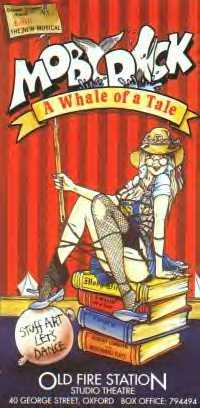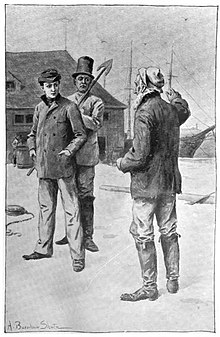
Herman Melville was an American novelist, short story writer, and poet of the American Renaissance period. Among his best-known works are Moby-Dick (1851); Typee (1846), a romanticized account of his experiences in Polynesia; and Billy Budd, Sailor, a posthumously published novella. At the time of his death, Melville was no longer well known to the public, but the 1919 centennial of his birth was the starting point of a Melville revival. Moby-Dick eventually would be considered one of the great American novels.

Moby-Dick; or, The Whale is an 1851 novel by American writer Herman Melville. The book is the sailor Ishmael's narrative of the maniacal quest of Ahab, captain of the whaling ship Pequod, for vengeance against Moby Dick, the giant white sperm whale that bit off his leg on the ship's previous voyage. A contribution to the literature of the American Renaissance, Moby-Dick was published to mixed reviews, was a commercial failure, and was out of print at the time of the author's death in 1891. Its reputation as a Great American Novel was established only in the 20th century, after the 1919 centennial of its author's birth. William Faulkner said he wished he had written the book himself, and D. H. Lawrence called it "one of the strangest and most wonderful books in the world" and "the greatest book of the sea ever written". Its opening sentence, "Call me Ishmael", is among world literature's most famous.

Queequeg is a character in the 1851 novel Moby-Dick by American author Herman Melville. The story outlines his royal, Polynesian descent, as well as his desire to "visit Christendom" that led him to leave his homeland. Queequeg is visually distinguished by his striking facial tattoos and tan skin. Ishmael encounters Queequeg in Chapter Four and they become unlikely friends. Once aboard the whaling ship the Pequod, Queequeg becomes the harpooner for the mate Starbuck.
The cetology in Herman Melville's 1851 novel, Moby-Dick, is a running theme that appears most importantly in Ishmael's zoological classification of whales, in Chapter 32, "Cetology". The purpose of that chapter, the narrator says, is "to attend to a matter almost indispensable to a thorough appreciative understanding of the more special leviathanic revelations and allusions of all sorts which are to follow." Further descriptions of whales and their anatomy occur in seventeen other chapters, including "The Sperm Whale's Head -- Contrasted View" and "The Right Whale's Head -- Contrasted View".

Pequod is a fictional 19th-century Nantucket whaling ship that appears in the 1851 novel Moby-Dick by American author Herman Melville. Pequod and her crew, commanded by Captain Ahab, are central to the story, which, after the initial chapters, takes place almost entirely aboard the ship during a three-year whaling expedition in the Atlantic, Indian and South Pacific oceans. Most of the characters in the novel are part of Pequod's crew.

Moby Dick is a 1956 American color adventure film directed and produced by John Huston, who co-wrote the screenplay with Ray Bradbury. A film adaptation of Herman Melville's 1851 novel Moby-Dick, the film stars Gregory Peck, Richard Basehart and Leo Genn and follows the exploits of Captain Ahab in pursuing and killing a gigantic sperm whale with whom he has a personal vendetta.

Moby Dick is a musical with a book by Robert Longden, and music and lyrics by Longden and Hereward Kaye, first staged in 1990. The plot follows the anarchic and nubile girls of St. Godley's Academy for Young Ladies who, determined to save the institution from bankruptcy, decide to stage Herman Melville's classic 1851 novel in the school's swimming pool. The musical is a mixture of high camp, music hall-style smut, and wild anachronism overflowing with double entendres; the lead role of headmistress/Captain Ahab is portrayed by a man in drag.
Moby-Dick is an 1851 novel by Herman Melville that describes the voyage of the whaleship Pequod, led by Captain Ahab, who leads his crew on a hunt for the whale Moby Dick. There have been a number of adaptations of Moby-Dick in various media.

Moby Dick is a 1930 American pre-Code film from Warner Bros., directed by Lloyd Bacon, and starring John Barrymore, Joan Bennett and Walter Lang. The film is a sound remake of the 1926 silent movie, The Sea Beast, which also starred Barrymore. It is the first film adaptation of Herman Melville's 1851 novel Moby Dick that includes a soundtrack.

Moby-Dick is an American opera in two acts, with music by Jake Heggie and libretto by Gene Scheer, adapted from Herman Melville's 1851 novel Moby-Dick. The opera received its premiere at Dallas Opera in Dallas, Texas, on 30 April 2010. Heggie dedicated the opera to Stephen Sondheim.
Moby Dick is a Canadian-German television miniseries based on Herman Melville's 1851 novel of the same name, produced by Tele München Gruppe, with Gate Film, In association with RTH/ORF. Starring William Hurt as Captain Ahab, it was directed by Mike Barker with a screenplay by Nigel Williams. The cast also includes Ethan Hawke as Starbuck, Charlie Cox as Ishmael, Eddie Marsan as Stubb, Gillian Anderson as Ahab's wife, Elizabeth and Donald Sutherland as Father Mapple.

Moby Dick is a 1998 American television miniseries directed by Franc Roddam, written by Roddam, Anton Diether, and Benedict Fitzgerald, and executive produced by Francis Ford Coppola. It is based on Herman Melville's 1851 novel of the same name. It was filmed in Australia in 1997 and first released in the United States in 1998. The miniseries consisted of two episodes, each running two hours with commercials on March 15 and 16 of 1998 on the USA Network. This is Gregory Peck's final on-screen role.

Captain Ahab is a fictional character and one of the protagonists in Herman Melville's Moby-Dick (1851). He is the monomaniacal captain of the whaling ship Pequod. On a previous voyage, the white whale Moby Dick bit off Ahab's leg, and he now wears a prosthetic leg made out of whalebone. The whaling voyage of the Pequod ends up as a hunt for revenge on the whale, as Ahab forces the crew members to support his fanatical mission. When Moby Dick is finally sighted, Ahab's hatred robs him of all caution, and the whale drags him to his death beneath the sea and sinks the Pequod.
Father Mapple is a fictional character in Herman Melville's novel Moby-Dick (1851). A former whaler, he has become a preacher in the New Bedford Whaleman's Chapel. Ishmael, the narrator of the novel, hears Mapple's sermon on the subject of Jonah, who was swallowed by a whale but did not turn against God.

Moby Dick is a fictional white sperm whale and the primary antagonist in Herman Melville's 1851 novel Moby-Dick. Melville based the whale on an albino whale of that period, Mocha Dick.
Walter E. Bezanson was a scholar and critic of American literature best known for his studies of Herman Melville and contributions to the Melville revival that restored the writer to prominence in the 1940s and 1950s. Bezanson's research and editorial work rescued from neglect Mevlille's unappreciated epic poem, Clarel, and he published essays on Moby-Dick that were widely cited and reprinted.
Bulkington is a character in Herman Melville's 1851 novel Moby-Dick. Bulkington is referred to only by his last name and appears only twice, briefly in Chapter 3, "The Spouter Inn", and then in Chapter 23, "The Lee Shore", a short chapter of several hundred words devoted entirely to him.
Pip, short for Pippin, is the African-American cabin-boy on the whaling-ship Pequod in Herman Melville's 1851 novel, Moby-Dick. When Pip falls overboard he is left stranded in the sea, and rescued only by chance and becomes "mad." The book's narrator, Ishmael, however, thinks that this "madness" gives Pip the power to see the world as it is. Pip is first described as "insignificant," but is the only member of the crew to awaken feelings of humanity in Ahab, the ship's monomaniacal captain.
"Fast-Fish and Loose-Fish" is chapter 89 of Herman Melville's 1851 novel Moby-Dick, in which Ishmael, the book's narrator, explains the concept of "Fast-Fish" and "Loose-Fish." If a whale, whether dead or not, is marked by a ship's crew with anything to claim it, such as a harpoon or rope, it is a "fast-fish", that is, it must be left alone by other whalers; if it is not so marked, it is a "loose-fish", which can be claimed by any ship that finds it. The clarity of this doctrine, Ishmael says, prevents disputes from escalating into violence. He describes court cases dealing with disputes between crews of whaling ships, and then extends the concept to society and politics, questioning the concept of ownership and the right to possession.










